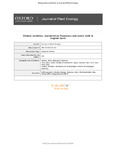Climate variation, reproductive frequency and acorn yield in English Oaks
| dc.contributor.author | Furtado Frota, Francisco Gabriel | |
| dc.contributor.author | Cook, BI | |
| dc.contributor.author | Fenner, M | |
| dc.date.accessioned | 2020-09-15T06:34:06Z | |
| dc.date.available | 2020-09-15T06:34:06Z | |
| dc.date.issued | 2019-06 | |
| dc.identifier.issn | 1752-9921 | |
| dc.identifier.issn | 1752-993X | |
| dc.identifier.uri | http://hdl.handle.net/10026.1/16250 | |
| dc.description.abstract |
AIMS -: Annually variable, but synchronous production of large seed crops ('masting') is a widespread phenomenon in temperate trees. Mounting concerns about the impacts of anthropogenic climate change (ACC) on plant reproduction, gives urgency to our need to understand better the role of climate on tree reproduction, and in particular, mast events. Unlike our understanding of reproductive phenology however, there is little consensus regarding how climate affects plant reproductive effort, or indeed the actual environmental triggers that underpin masting behaviour. METHODS -: We used a 27-year record of acorn yield from a population of 12 Quercus robur trees located in southern England to compare masting frequency and post-dispersal acorn yield each year for each tree, with long-term weather data over the same period. We focussed on discrete or sequential climate cues (temperature, precipitation, and frost days) as likely predictors of oak reproduction. IMPORTANT FINDINGS -: Annual post-dispersal acorn crop varied greatly; i.e. no acorns in 14 of the 27 years, but there was no sequential pattern of crop versus non-crop years indicating that weather, rather than resource limitation alone, dictated the timing of reproduction. Crop years were instead most closely associated with relatively cool late summer conditions in the preceding year, followed by anomalous summer warmth within crop year. Acorn yield increased following dry April and above average May and June temperatures within crop year. Although our results support a general association between warm late spring and summer conditions, and crop frequency and yield respectively, the influence of cooler later summer conditions in the year prior to masting highlights how a combination of weather cues may dictate the occurrence of mast years. Consequently, our results corroborate not only the hypothesis that temperature differentials between consecutive years, not absolute temperatures, may be the better predictor of mast seeding events, but lend support also to the suggestion that reproductive failure and resource accumulation resulting from a climate-linked environmental veto, drives future reproductive synchronization in temperate tree species. | |
| dc.format.extent | 542-549 | |
| dc.format.medium | Print-Electronic | |
| dc.language | en | |
| dc.language.iso | en | |
| dc.publisher | Oxford University Press (OUP) | |
| dc.subject | anthropogenic climate change | |
| dc.subject | environmental veto | |
| dc.subject | Moran effect | |
| dc.subject | Quercus robur | |
| dc.subject | reproductive effort | |
| dc.title | Climate variation, reproductive frequency and acorn yield in English Oaks | |
| dc.type | journal-article | |
| dc.type | Journal Article | |
| plymouth.author-url | https://www.webofscience.com/api/gateway?GWVersion=2&SrcApp=PARTNER_APP&SrcAuth=LinksAMR&KeyUT=WOS:000469786800014&DestLinkType=FullRecord&DestApp=ALL_WOS&UsrCustomerID=11bb513d99f797142bcfeffcc58ea008 | |
| plymouth.issue | 3 | |
| plymouth.volume | 12 | |
| plymouth.publication-status | Published | |
| plymouth.journal | Journal of Plant Ecology | |
| dc.identifier.doi | 10.1093/jpe/rty046 | |
| plymouth.organisational-group | /Plymouth | |
| plymouth.organisational-group | /Plymouth/Faculty of Science and Engineering | |
| plymouth.organisational-group | /Plymouth/Faculty of Science and Engineering/School of Biological and Marine Sciences | |
| plymouth.organisational-group | /Plymouth/REF 2021 Researchers by UoA | |
| plymouth.organisational-group | /Plymouth/REF 2021 Researchers by UoA/UoA06 Agriculture, Veterinary and Food Science | |
| plymouth.organisational-group | /Plymouth/Users by role | |
| plymouth.organisational-group | /Plymouth/Users by role/Academics | |
| dc.publisher.place | England | |
| dcterms.dateAccepted | 2018-11-13 | |
| dc.rights.embargodate | 2020-9-18 | |
| dc.identifier.eissn | 1752-993X | |
| dc.rights.embargoperiod | Not known | |
| rioxxterms.versionofrecord | 10.1093/jpe/rty046 | |
| rioxxterms.licenseref.uri | http://www.rioxx.net/licenses/all-rights-reserved | |
| rioxxterms.licenseref.startdate | 2019-06 | |
| rioxxterms.type | Journal Article/Review |


